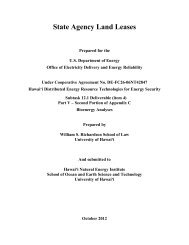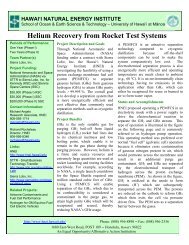Oahu Wind Integration Study - Hawaii Natural Energy Institute ...
Oahu Wind Integration Study - Hawaii Natural Energy Institute ...
Oahu Wind Integration Study - Hawaii Natural Energy Institute ...
You also want an ePaper? Increase the reach of your titles
YUMPU automatically turns print PDFs into web optimized ePapers that Google loves.
List of Figures<br />
Figure 1-1. Illustrative schematic of the <strong>Oahu</strong>, Molokai, and Lanai interconnection.................................................... 5<br />
Figure 1-2. Renewable <strong>Integration</strong> Studies conducted by GE ....................................................................................... 7<br />
Figure 1-3. An example of operation for the Baseline 2014 <strong>Oahu</strong> power system ......................................................... 8<br />
Figure 1-4. An example week of operation for the <strong>Oahu</strong> power system with 500 MW of wind power and 100 MW of<br />
solar power (Scenario 5)............................................................................................................................. 9<br />
Figure 1-5. An example week of operation for the <strong>Oahu</strong> power system with 500 MW of wind power and 100 MW of<br />
solar power (Scenario 5)........................................................................................................................... 10<br />
Figure 1-6. Share of annual energy production by fuel and unit type for each scenario............................................. 11<br />
Figure 1-7. Total annual fuel consumption by Scenario............................................................................................. 12<br />
Figure 1-8. Total annual variable cost of operation..................................................................................................... 13<br />
Figure 1-9. Scenario 5. Reduction in variable cost and increase in wind and solar energy delivered for staged<br />
strategies. .................................................................................................................................................. 14<br />
Figure 1-10. Histogram of total wind power changes over 60-minute for Scenario 5 for the wind energy delivered to<br />
the <strong>Oahu</strong> system (two years of simulated wind power data from AWS Truepower)................................ 18<br />
Figure 1-11. Frequency performance during largest 60-minute wind power drop ..................................................... 19<br />
Figure 1-12. Large wind, solar, load change over 10 minute that challenged the system ramp rate capability.......... 20<br />
Figure 1-13. Impact of large swings in wind power on system frequency with the proposed thermal unit ramp rate<br />
capability and droop response (Scenario 5) .............................................................................................. 21<br />
Figure 1-14. 200 MW cable trip event in Scenario 5 with future thermal unit droop characteristics, with and without<br />
wind turbine inertial-type response. Second figure shows response from remaining off-island wind<br />
plant. ......................................................................................................................................................... 22<br />
Figure 1-15. 140 MW load rejection event in Scenario 5 with future thermal unit droop characteristics, with and<br />
without wind turbine over-frequency control (3% droop / 30 mHz deadband). ....................................... 24<br />
Figure 5-1. GE power system modeling tools for the <strong>Oahu</strong> <strong>Wind</strong> <strong>Integration</strong> <strong>Study</strong>................................................. 47<br />
Figure 5-2. Illustration of the cumulative effect of modeling uncertainties and limitations on the annual fuel energy<br />
consumption on <strong>Oahu</strong>............................................................................................................................... 54<br />
Figure 5-3 GE MAPS<br />
57<br />
57<br />
63<br />
72<br />
74<br />
75<br />
76<br />
81<br />
82<br />
83<br />
84<br />
85<br />
86<br />
87<br />
88<br />
89<br />
91<br />
92<br />
95<br />
TM model results compared to historical hourly generation data for 4 days, starting September<br />
13, 2007 and ending September 16, 2007.................................................................................................<br />
Figure 5-4 Electricity production, by unit type, for 2007. ...........................................................................................<br />
Figure 5-5 Baseline Model Database modeling in GE PSLF TM ...................................................................................<br />
Figure 5-6 AGC model block diagram in normal operation mode ..............................................................................<br />
Figure 5-7 Exhibit 12, Scenario 3, Fast AGC Tuning, Simulated vs. Actual Frequency (wide scale) ........................<br />
Figure 5-8 System Frequency Response without “Once in a while” ramp rates in AGC............................................<br />
Figure 5-9 System Frequency Response with “Once in a while” ramp rates in AGC .................................................<br />
Figure 6-1 Kaheawa <strong>Wind</strong> Plant, Maui historical (2007 June) data Note that curtailment periods were removed from<br />
the historical data......................................................................................................................................<br />
Figure 6-2 Ten minute wind power changes, based on two years of data, for Scenario 5 and Scenario 3 ..................<br />
Figure 6-3 The largest 1 minute wind power drop for 100 MW <strong>Oahu</strong> + 200 MW Molokai + 200 MW Lanai<br />
(Scenario 5, excluding PV) from 2007 and 2008 modeled wind power data............................................<br />
Figure 6-4. <strong>Wind</strong> and solar power variability for Scenario 5 (2007 on left, 2008 on right) .......................................<br />
Figure 6-5. Histogram of wind power variation at 1 minute, 5 minute, and 10 minute interval for 2007 and 2008<br />
wind power data........................................................................................................................................<br />
Figure 6-6. Histogram of wind power drops for each hour of the year (2007 wind data, reducing off-island wind<br />
power by 5% due to HVDC losses). No solar power changes are considered.........................................<br />
Figure 6-7. Histogram of wind and solar power changes for each hour of the year (2007 wind data, reducing offisland<br />
wind power by 5% due to HVDC losses).......................................................................................<br />
Figure 6-8. Histogram of wind forecasting error (actual power – forecasted power), for two years of data, for 100<br />
MW <strong>Oahu</strong> + 400 MW Lanai (Scenario 3, excluding solar power). ND = next day.................................<br />
Figure 6-9. Scenario 5: 10 minute drops in wind power as a function of the wind power available at the start of the<br />
10 minute interval. Results based on 2007 and 2008 modeled wind data from AWS Truepower...........<br />
Figure 6-10. Thermal unit heat rates for Baseline 2014 .............................................................................................<br />
Figure 6-11. 2007 and 2014 load shapes ....................................................................................................................<br />
Figure 6-12. Baseline 2014 scenario. Annual energy production by unit type..........................................................<br />
32




